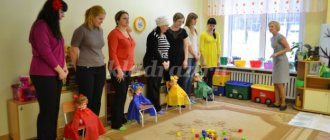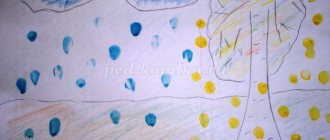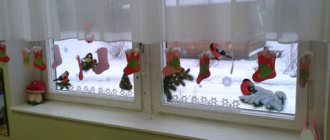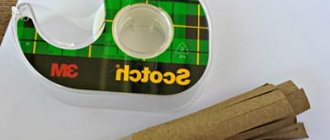Summary of educational activities during restricted periods for children of the 1st junior group
A brief summary of direct teaching activities during the regime for boys of the 1st junior group on the topic:
"Water, water..."
Integration of educational areas:
“Cognition”, “Communication”, “Narrative reading”, “Work”, “Socialization”, “Music”.
Tasks:
Improve your self-washing skills for your hands and face.
Teach children to correctly name hygiene items.
Continue to develop the skill of using a custom towel and comb.
Develop independence and tactile sensations.
Develop cultural and hygiene skills.
Expand your vocabulary: scented soap, towel.
Activate words in children’s speech that denote action: wash, roll up sleeves, lather, wash with soap, comb hair.
Continue teaching your children how to answer the simplest questions.
Methodological techniques:
A game situation showing the teacher, the teacher's actions with the children, the teacher's questions and the children's answers, explanation, showing toiletries, reading children's poems, excerpts of poems, offering children the opportunity to complete words and sentences while reading children's poems and familiar poems.
Preparatory work:
Talking about the purpose of soap, how it happens; studying plot images depicting objects used for washing, using in educational games “Wonderful Bag”, “We will teach Katya to wash”, “Misha visiting Masha”, “Dolls for the bath”. We got acquainted with water, with its property, where it can be found... We learned new sit-down games “We woke up...”, “Washbasin” (a gray rabbit washed his face as a guest...), nursery rhymes, finger games, reading excerpts from a poem by K.I. "Dirty Girl" and other works.
Equipment
: a bag of soap of different colors and shapes, a towel, a comb, a drawing.
Strike:
Children are included in the group.
Educator: Guys, look how many guests we have today. We say hello to them (stand in a circle).
Guys, how beautiful, neat, neat you are. I see you are in a good mood today.”
The teacher invites the children to play a little.
The teacher shows the movements, reads the text of the poem, and the children repeat after the teacher.
Woke up early in the morning (marching in place),
Have a fun, noisy stretch (stand on tiptoes, spread your arms up to the sides);
What else to read: Sensory games for visually impaired preschool children
To make the dream go away, they yawned
The head was slightly shaken (turns left and right. Hands are placed on the shoulders).
Woke us up by running on the spot (running on the spot),
They ran to the bathroom together (they will do the “spring” exercise. Hands on the belt.)
Dressing algorithm
An adult is capable of reasoning logically and will even put on a new thing at the moment that requires it. It is more difficult for a child to cope with a large set of things, especially if. Winter means sweaters, scarves, gloves, tights - of course, it’s very easy for a child, and sometimes even a preschooler, to get confused. We need a logical, understandable diagram.
The correct algorithm is best presented in pictures, where dressing is shown very clearly. Remember that hanging it at eye level of an adult is a pointless idea. You need to place the reminder at the level of children's eyes so that it is convenient for everyone to come up and clarify what is currently worth. A doll located in the locker room can serve as a visual aid. On it, in their free time from walking, children can train and hone their knowledge of dressing and undressing. Gradually, the sequence of actions in the pictures will be assimilated, and the children will begin to gather faster.
| In what order should you dress for a walk? | |
| 1. Put on tights | |
| 2. Put on socks | |
| 3. Put on a T-shirt | |
| 4. Putting on pants | |
| 5. Wear a sweater or jacket | |
| 6. Putting on shoes | |
| 7. We put on a hat | |
| 8. Put on a jacket | |
| 9. Tie a scarf | |
| 10. Wear gloves or mittens | |
Calendar and thematic planning in the second junior group “Safety Week”
Morning
Free activity under the supervision of a teacher.
Goal: to train the ability to ask for toys and exchange them. Develop friendships.
Outdoor Activity: Encourage children to observe indoor plants. Offer to water the plants yourself without climbing on the leaves. To foster a caring attitude towards plants, to consolidate children’s skills and plant care skills.
Morning exercises
– general improvement of the body, development of coordination of movements, training of motor skills.
Game exercise “The doll washes itself” Purpose: to teach children cultural and hygienic skills, pay attention to the sequence of actions, teach children to thoroughly wash their hands and face, explain why they need to dry themselves thoroughly. Develop a careful attitude towards your health.
Conversation “Safety in our group” Goal: consolidate the knowledge of your group, develop the ability to navigate the group’s space, a sense of security and self-preservation; enrich the understanding of the accessible subject world, the purpose of objects, the rules for their safe use; reveal accuracy, respect for group objects.
KHL “Confusion” by K. Chukovsky and nursery rhymes “Tilibom, Tili-bom...”.
Purpose: to give basic ideas for handling matches and hot objects, to clarify how the heroes managed to put out the fire. To cultivate a sense of empathy and joy for the characters of the works.
P / N “Crow and Dog” Purpose: to teach to imitate the movements and voices of birds; learn to move without interfering with each other, increase the craving for physical activity.
Work before bed.
CGN and self-care skills training.
Continue to culturally accustom yourself to behave at the table (eat carefully and independently, chew food well, use a spoon, hold it in your right hand, do not crumble when getting up from the table, push the chair slowly, thanks to the adults.
Learn on your own, take off your clothes before going to bed and fold them neatly on the high chair.
KHL fairy tale “Golden comb rooster”. Goal: to continue learning how to behave in the house when you are suddenly alone, to form the idea that you cannot open the door for anyone.
What else to read: Consultation for educators “Peculiarities of perception of the size of objects by preschool children,” teacher Manuilova L.M.
Relaxation before bed - listening to folk lullabies. Purpose: to prepare children for bed.
Evening
Health-improving exercises after sleep. Hardening: air baths. Purpose: strengthening immunity and general well-being.
Walk along the “Health” trails. Goal: prevention and correction of flat feet, development of a sense of balance and coordination of movements.
Breathing exercises “Look” Purpose: articulatory breathing training; coordination of hand movements with chest breathing movements.
Consideration of the illustration by Yu. Vasnetsov “Cat House”. Goal: to teach children to carefully examine the illustration, noting the main thing and details in it; develop perception and memory, speech; cultivate a desire to help those in need.
D/I “What kind words do we know?” Goal: to form a culture of communication and a culture of behavior, to continue to teach children to use words expressing a request, gratitude “please”, “thank you”, to teach them to say hello and goodbye, to use the words “see you later” next time.” Cultivate the desire to be an educated child.
Situational conversation “Contacts with strangers” Purpose: To consider and discuss with children the dangerous situations of possible contacts with strangers on the street; Teach your child to behave correctly in such situations. Cultivate a respectful attitude towards yourself.
D / D “What burns, what doesn’t burn” Purpose: to give children an idea of the benefits and dangers of fire. Reinforce your knowledge of what burns and what doesn't. Expand your vocabulary. Develop interest in the game
P/U “Semaphore” Purpose: to strengthen children’s ability to act on a signal; continue to know the designations of traffic lights, consolidate knowledge about colors, cultivate a desire to know the rules of the road.
Research Institute “Tanya the Doll Got a Cold” Goal: to develop independence in choosing roles, develop the ability to use substitute objects, promote the formation of the ability to use a handkerchief, and cultivate a caring attitude towards others.
Autonomous activity in the creativity center: Painting with colors “Car with wheels”. Goal: to teach how to draw rounded lines - wheels, to teach how to hold a brush freely, to draw paint on a brush, to remove excess paint, to increase accuracy in work.
Summary of regime processes
Summary of regime processes
Summary of routine processes in the 1st half of the day in the 1st junior group: morning reception, washing, feeding, preparing for a walk (dressing), returning from a walk (undressing), preparing for bed and going to bed.
Morning reception
Goal: to create a cheerful emotional state for the whole day, to ensure a calm separation of children from their parents. Conduct: 10-15 minutes before I come to the group, ventilate the room, prepare the toys. I greet each child kindly and greet him and his parents with a smile. I ask the parents: “How did the child sleep?”, “How is he feeling?”, “In what mood did he go to kindergarten?” or I ask the child himself: “Well, how are you? Will you play with us today? Then I bring the child into the group and offer him an activity (dolls, cars, cubes, mosaics). During the reception, if the child does not want to part with his parents, I use musical and ).
Washing
Goal: to teach children to gently place their hands under the stream of water, to rub their hands, to use soap, to find their own towel, to dry their hands independently, to teach them not to be afraid of water.
Conduct: While the nanny is putting breakfast on the tables, I call 2-3 children who are eating slowly and say: “Guys, do you want your hands to be clean? Let's wash them." I take the children to the washbasin and say: “We roll up our sleeves so as not to get them wet, and now open the tap with warm water. I make sure (if necessary I help) that the children open the tap. When water flows from all the taps, I use a literary word: Clean water is flowing. We know how to wash with you
- We put our hands under the water with a boat (I show it to the children).
Now take the soap and lather your hands in a circular motion. They washed their ears with soap, they washed their hands with soap, these are the little hands, little hands, little hands.
— We put the hands under the water again and rinse off the soap well. Shake the remaining water into the sink and turn off the tap. Now everyone goes to the towel and wipes their hands dry on all sides; we hang the towel back in its place. So our hands have become clean!
Feeding
Goal: To provide rational nutrition to all children, teach them to eat correctly, develop cultural and hygienic eating skills (eat independently and carefully, use a napkin, do not crumble bread, push in a chair, say thanks after eating, rinse your mouth), cultivate a favorable attitude towards eating.
Conduct: “Children, everyone who has washed their hands, sit down at the tables. Sit up straight, put your legs straight, do not put your elbows on the table. Everyone is sitting upright, Legs are standing together, Eyes are looking at the plate, Elbows are removed from the table, The children are eating quietly. Children!
Not Doctor Aibolit came to visit today
Came to visit today -
Good Appetite! Bon Appetit everyone!"
While eating, I make sure that the children hold the spoon correctly, sit up straight, and eat in silence. I tell you how beneficial it is when children eat: they grow quickly and never get sick. I try to convince children who don’t eat that they need to eat at least a little (unless they have a reason not to eat). For those guys who eat slowly or don’t know how to eat, I feed them with a separate spoon. To the child who has eaten, I say: “Dasha, take a napkin and wipe your mouth, don’t forget to say “thank you” and push up the chair.”
Preparing for a walk (dressing)
Goal: to ensure timely collection of all children for a walk;
form the correct sequence when dressing, develop children’s speech (fix the names of items of clothing, actions). Conduct: Before going out for a walk, I remind the children to go to the toilet. Then I take a subgroup of children and we go out to the locker room together. I begin to dress the children for a walk, observing the principle of gradualness: tights, socks, pants, boots, jacket, hat, jacket, mittens, scarf. During this I use an artistic word: We dress in order, We get used to order.
I ask the children: - Danila, what color are your pants? - Vanya, what do we put on our heads? If the children cannot answer, I help them. I encourage the children to dress themselves: “Kolya, show me how you can put on your pants.” — Children, in order for our clothes to be clean, we need to walk carefully and not run through puddles.
Returning from a walk (undressing).
Goal: ensure timely arrival from a walk, develop cultural and hygienic undressing skills (neatly fold things and put them in the closet, do not jostle near lockers), develop speech (reinforce the names of items of clothing, actions). Conduct: I ask all children to wipe their feet when entering the kindergarten (I show how to do this) - How cheerful you all are when you came from your walk! Do you want to go to a group to play? Let's carefully undress. I take off all the children’s scarves and untie their hats, then I invite them to undress themselves. - First we take off the jacket, then the hat, jacket, pants, boots, tights and, finally, socks. I make sure the children are neat after a walk: “Dasha, look how dirty your pants are!” What kind of pants did you wear?” (clean). I also turn to other children: “Yulia, what are you filming now? Christina, where will you hang your jacket?”
Preparation for sleep.
Goal: create a calm atmosphere in the room, consolidate cultural and hygienic skills (neatly fold clothes: hang them on a chair, do not jostle near chairs, ensure a restful sleep).
Conduct: I take the children one by one to the toilet, then to the bedroom. - Guys, today we played so well and our hands, eyes and legs are tired and want to rest. Take your chairs and we'll undress. Children, does everyone remember how to put their clothes on chairs? I help the children undress. I put children in bed first who take longer to fall asleep. Let's put a soft feather bed under the back. On top of the feather bed, a clean sheet. Put white pillows under the ears. And cover with a blanket so that the children sleep soundly.
— Guys, who have undressed, lie down in bed and cover yourself with a blanket.
When all the children are lying in their cribs, I say in a calm, quiet voice: So people are sleeping, So animals are sleeping. Birds sleep on branches, Foxes sleep on hills, Hares sleep on grass, Ducks sleep on ants, Children are all in their cradle... They sleep and sleep, they tell the whole world to sleep. Now we lie down on our side and close our eyes. Pleasant dreams!
While the children are sleeping, I keep an eye on them (so that they don’t open up, so that they don’t fall).
Summary of the regime processes in the 2nd half of the day in the 1st junior group
Lifting and hardening
Goal: to ensure a joyful and cheerful emotional mood for children after sleep. Cultivate a positive attitude towards the lifting process. Carrying out. I go into the bedroom and say in a calm voice: “Children, you slept, but it’s time to get up.” I think you've all had some interesting dreams. I go up to the children who haven’t woken up and quietly say that it’s time to get up. - Guys, now let’s each stand near their crib. I carry out hardening procedures: - Children, show your hands - “here they are”, and now let’s hide our hands behind our backs - “where are the hands”? "Here they are!" (Showing hands) Well done! Children, now look out of this window (I show the window), there is nothing there. Now look out the other window, there we see a car. Let's look again at the first window - there is nothing, and now at the second. Guys, let’s hide behind the beds (we squat next to the bed), and now we’ll show how big we are (we stand up to our full height). What a great fellow you are! The big ones have already grown. Now let's take your sandals in your hands and go to your chairs with clothes.
Dressing
Goal: teach to dress in the correct sequence; encourage independence in the process of dressing, teach to notice and correct untidiness in clothing, and cultivate a friendly attitude towards each other. Conduct: Children sit on their chairs, I help the children get dressed, observing the principle of gradualness: tights, skirts and panties, sandals, a jacket. When dressing, I use the artistic word: We dress in order, We get used to order. I ask the children - Vanya, what are you wearing now? - Katya, who bought you such a beautiful dress? - Olya, please tell me, what color is your sweater? If the children cannot answer on their own, I help them. I encourage children to dress themselves.
Washing:
Goal: continue to teach children the skills of proper washing: roll up their sleeves, wash their hands with soap in a circular motion, dry them with a towel, cultivate neatness and organization. Carrying out I take the children who eat more slowly, take them to the washbasin and say: “We roll up our sleeves so as not to get them wet, and now open the tap with warm water.” I make sure (if necessary I help) that the children open the tap. When water started flowing in all the taps, I used the artistic word: Ay, okay, okay, okay, we are not afraid of water, we wash ourselves clean, we smile together. We put the handles under water and wet them. Now take the soap and lather your hands in a circular motion (I show). We put our hands under the water again and wash off the soap. Shake off the remaining water and close the tap. Now everyone goes to the towel and wipes their hands dry on all sides. Dasha won’t take Katino’s towel. The Blue Plane will not be confused with a bird. Well done, children, everyone is so clean and beautiful!
Feeding
Goal: to develop cultural and hygienic eating habits, eat carefully, chew food thoroughly, learn to use a napkin, pull up a chair, and say thank you for food. Conduct: - Children, everyone who has washed their hands, sit down at the tables. Sit up straight, don’t slouch, put your legs straight, don’t put your elbows on the table. Everyone is sitting upright. Legs are standing together. Elbows are removed from the table. The children are eating quietly. Bon Appetit everyone! During meals, I make sure that the children sit up straight and eat in silence. At the end of the meal, I remind each child to wipe their mouth and hands with a napkin. I remind you that children should pull their chairs behind them, say thank you, and not interfere with others’ meals.
Get text
A few rules
For kids 3-4 years old, it is, of course, very difficult, even impossible, to deal with clothes on their own and monitor their complete composition (of course, if we are not talking about summer walks, when changing clothes, dressing and undressing is reduced to a minimum). The task of a preschool teacher is to help every child, but not in the form of guardianship, but in the form of tips and games. It is important to adhere to the algorithm for putting on things in the pictures, but still the desire for independence is necessary. To prevent the training process from taking too long, introduce a number of rules for the guys:
- Each preschooler can get dressed only near his locker.
- We need to help each other.
- You need to ask for help and thank for its provision.
- Any clothes should be in their place (the top tier in the closet is for a change of clothes) and should preferably be available in the sequence that the dressing algorithm will correspond to.
- The child should only take out from the locker what he intends to wear, without losing the sequence.
Children should find it comfortable and fun to dress for a walk, because they will have to do this every day. It is necessary for the children's skills to develop. A preschool teacher should not forget about the health safety of his charges - children who get dressed earlier than others may have time to sweat and catch a cold in the cold air. Demonstrate to the children what undressing should be like by removing things in reverse order. The vigilance of the teacher and the good mood of the children coming to kindergarten are the key to a successful outing. And don’t forget after your walk!



